The second iconic ship of the XIX Century featured in the Sails of Glory Special Ship Packs is the USS Constitution 1797 (1812) or "Old Ironsides," the oldest commissioned ship in the U.S. Navy. This wooden hull, three-masted frigate was launched in 1797 to provide protection for American merchant ships from Barbary pirates’ attacks and French aggression, but she’s most known for her actions during the War of 1812 against Great Britain, when she captured numerous merchant ships and defeated five British warships.
The Constitution was one of the first six original frigates (three of 44 guns and three of 36 guns) authorized by the US Congress by the Naval Act of March 27, 1794 - considered the birthday of the United States Navy. The ships Constitution, President, United States, Chesapeake, Constellation, and Congress were designed by Joshua Humphreys to be powerful enough to engage any frigates of the French or British navies, yet fast enough to evade any ship of the line.
One of the 44-gun warships, Constitution was commissioned to Edmund Hartt’s shipyard in Boston, Massachusetts, on 28 June 1794, and her keel was laid in the Summer of 1795. In November of that year, with the design and preparatory work almost completed, the construction was halted, as the US reached a peace treaty with Algiers to stop the pirates’ attacks. Construction resumed in April 1796. She was launched on 21 October, 1797.

USS Constitution sails in 2012 during the commemoration of the 200th anniversary of the victory over Guerriere. (US Navy*)
Approximately 2,000 pine and oak trees were used in the building of the Constitution. Her overall length was 62 meters, with a beam of 13.25 meters, a draught of 7 meters, 2,200 tons of displacement, and a speed of over 13 knots. She was rated as a 44-gun, but her battery of guns typically consisted of thirty 24-pounder (11 kg) cannons and twenty-two 32-pounder (15 kg) carronades. In 1797, her crew complement was of 450 men, including 55 Marines and 30 boys.
In Spring 1798, Constitution was fit out as a warship. On 22 July she put to sea commanded by Captain Samuel Nicholson, to patrol the southeast coast of the United States during the Quasi-War to defend American ships trading with Britain against French privateers. In late December, she sailed to the Caribbean, joining Commodore John Barry’s squadron at Dominica until May 1999, when she was recalled to Boston. In July, with Captain Silas Talbot as commander and serving as Commodore of operations in the West Indies, the Constitution departed again to Saint-Domingue, remaining until the end of the hostilities and then returning to United States in April 1801.
The Constitution then was laid out at Boston in ordinary and was finally repaired in May 1803. In August, she was assigned to sail as flagship of the third Mediterranean squadron, under Commodore Edward Preble, against Tripoli, which was demanding United States tribute to allow American merchant vessels access to Mediterranean ports. The war against Tripoli ended in June 1805, with a treaty signed aboard of Constitution, commanded by Captain John Rodgers. She remained as Mediterranean Squadron flagship until 1807, and in September she sailed back to United States, remaining in New York for two years.
In December 1809, Constitution was recommissioned to be refitted under the command of Rodgers, but he declared her a "slow sailer" and took command of USS President. In June 2010, Isaac Hull became the new captain, and she joined the Northern Squadron. In August 1811, she sailed to France with the new Ambassador, remaining near France and Holland through the winter months, keeping the crew ready for possible hostilities with the British, as tension ran high. Back to US in February 1812, the Constitution was overhauled to become faster and prepare for the imminent war.
The Constitution left the Washington Navy Yard three days after the was declared, on 21 June, and after taking crew and stores, Hull set course to join Commodore Rodgers' squadron. On 19 August, she met the British 39-guns frigate HMS Guerriere (a captured French ship), commanded by Captain Dacres, and fought her legendary battle, which gave her the nickname “Old Ironsides.”
The two warships spent one hour maneuvering for advantage, and then were in fighting range. Guerriere fired the first shot, but caused little damage to Constitution, which saved her fire to engage the enemy in close action. When they drew alongside, about 25 yards apart, Constitution fired a full broadside. Guerriere launched her 18-pound iron cannonballs, but her fire bounced harmlessly the American frigate's strong oak planking, to the astonishment of the British ship sailors, who called out, “her sides must be made of iron.”
In 20 minutes of fighting, the mizzenmast of Guerriere went over the side, and she soon lost also the remaining two masts. With the gun-deck ports barely above the waterline, the British surrendered. HMS Guerriere was so damaged she was burned after the transfer of her crew to Constitution as prisioners. When she arrived at Boston, Captain Hull and his crew were hailed as heroes.
On 29 December, under the command of William Bainbridge, Constitution defeated another British frigate, Java, in a three-hour engagement about 30 miles off the coast of Brazil. To badly damaged to continue and with Captain Henry Lambert mortally wounded, Java surrendered. But this time, the Constitution was also damaged and went back to Boston for repairs. After many months, she was back to action, capturing eight more ships until the war, including the HMS Cyane and HMS Levant, engaged simultaneously on February 20, 1815 under the command of Captain Charles Stewart.
From 1816 to 1821, the Constitution was laid up and repaired, returning to duty as flagship of the Mediterranean Squadron under the Captain Jacob Jones. She was decommissioned again in 1828. Declared unseaworthy and considered for scrap by a board of inspection, she was preserved and rebuilt after a wave of public protest. She served as flagship in the Mediterranean and the South Pacific, and made a 30-month voyage around the world beginning in March 1844.
In the 1850s, she was the African Squadron flagship, patrolling the coast in search of slavers, and in 1853, she captured her last prize. During the Civil War, she served as a training ship. Retired from active service in 1881, she served as a receiving ship until designated a museum ship in 1907, saved again by public sentiment. Recommissioned in 1931, she set out under tow for a tour of 90 port cities along the Atlantic, Gulf, and Pacific coasts of the United States. In 1941, she was placed in permanent commission, and a 1954 act of Congress made the Secretary of the Navy responsible for her upkeep. In 2008 she was restored to return her to 1812 appearance.
USS Constitution in Sails of Glory
The USS Constitution Special Ship Pack includes game data of two different versions of the ship: USS Constitution (1798), soon after her launch, and USS Constitution (1812), as equipped during the war against Great Britain. Players may choose the version they prefer to play, based on gameplay or historical considerations.
The gaming stats of USS Constitution clearly show how powerful this class of frigates was – the armament and speed are a match for an English two-decker, but her maneuverability is similar to much smaller frigates, making her a fearsome opponent for any enemy ship.
Similarly to HMS Victory, the USS Constitution is also an enhanced ship pack, including two sets of Captain Cards, representing the specific and unique skills of two of the most famous commanders of this vessel: Commodore William Bainbridge and Captain Charles Stewart. In addition to the Captain Cards, Constitution’s pack also includes a set of Crew Cards, focusing on the skills of the brave men fighting on this vessel.
Commodore William Bainbridge commanded the Constitution at the time of the famous engagement against HMS Java. Born in May 1744, in New Jersey, he previously commanded the Retaliation, George Washington, and Philadelphia. He was in command of the latter when it grounded off the shores of Tripoli pursuing a Tripoline vessel on October 21, 1803. Forced to surrender, Bainbridge and his crewmen were imprisoned in Tripoli for nineteen months. Bainbridge was released from the prison on June 3, 1805 and returned to the United States. A Naval Court of Inquiry tasked with looking into his surrender found no evidence of misconduct, and he was allowed to continue service.
In 1809 he took command of USS President, and then in September 1812, he was assigned to command the Constitution. On December 29, 1812, he fell in with HMS Java and defeated the British frigate, maintaining command after being wounded twice and having the ship’s helm shot away. The missing helm was replaced with the one from the Java, before she was destroyed and sank. To this day, the Constitution sports the helm Bainbridge salvaged from the Java. Presented with the Congressional Gold Medal for his service aboard the Constitution on March 3, 1813, he later commanded the Mediterranean Squadron and two Navy Yards, finally serving on the Board of Navy Commissioners.
Captain of Constitution for two years, starting in July 1813, Charles Stewart was in command when she captured HMS Cyan and HMS Levant, in February 1815. Born in July 1778, in Pennsylvania, he had commanded USS Experiment in the Quasi-War with France and Siren during the Barbary War, in the Mediterranean. He took part in the destruction of Philadelphia after her capture by Tripoli, and helped maintain the blockade of Tripoli, distinguishing himself in assaults on the enemy in August and September 1804.
He commanded three warship successively during the War of 1812 - Argus, Hornet, and Constellation, before taking command of Constitution and taking the frigate on two cruises, in 1813 and 1815. On February 29, 1815, about 180 miles off Madeira, he encountered the 22-gun sixth-rate frigate HMS Cyane and the 20-gun Cyrus-class sixth-rate HMS Levant. The two ships began a series of broadsides against Constitution, but Stewart outmaneuvered both of them, first engaging Cyane, and then Levant. After taking concentrated fire, Cyane struck her colors, and Levant, which had returned to engage Constitution, turned and attempted escape. Constitution overtook her, and after several more broadsides, she too struck her colors. By capturing two British warships with a single ship of his own, Stewart became a national hero and was awarded the Congressional Gold Medal on 22 February, 1816.
Stewart later commanded two squadrons and the Philadelphia Navy Yard, and served on the Board of Naval Commissioners. He was promoted to "Senior Flag Officer" in 1859 and was placed on the retired list on 21 December 1861 after serving 63 years in the Navy. At 83 years, 4 months and 24 days – he was the oldest officer on active duty in the history of the U.S. Navy. He was promoted to rear admiral on the retired list on July 16, 1862, and has had a destroyer and a destroyer escort named after him.
Information sources: USS Constitution Museum, America's Navy, History.com, Wikipedia, "The 44-gun Frigate USS Constitution - Old Ironsides" (Karl Heinz Marquardt, Naval Institute Press). Images: * U.S. Navy photo by Mass Communication Specialist 1st Class Andrew Meyers/ Released, ** Naval Historical Center.

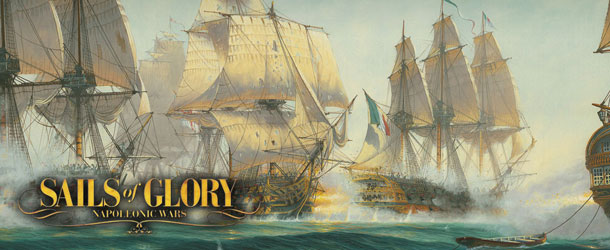
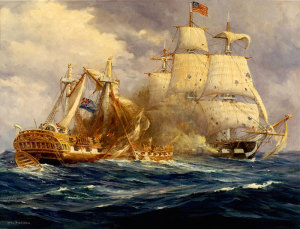
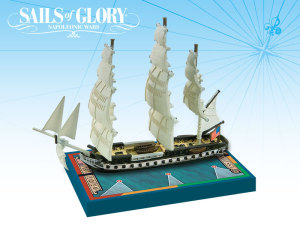
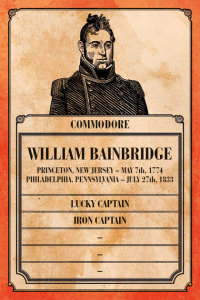
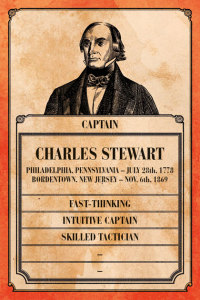








Follow Us on